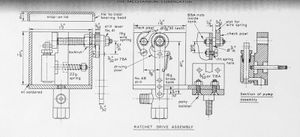Machining Lubricator Ratchet Wheels: Difference between revisions
(Created page with "[http://www.chaski.org/homemachinist/viewtopic.php?f=8&t=91041&p=222435&hilit=LBSC+Mechanical+Lubricator#p222435 Post by Carrdo on Chaski.org, 6 March 2003] I have a number o...") |
No edit summary |
||
| Line 1: | Line 1: | ||
[[Category:Construction]] | |||
[http://www.chaski.org/homemachinist/viewtopic.php?f=8&t=91041&p=222435&hilit=LBSC+Mechanical+Lubricator#p222435 Post by Carrdo on Chaski.org, 6 March 2003] | [http://www.chaski.org/homemachinist/viewtopic.php?f=8&t=91041&p=222435&hilit=LBSC+Mechanical+Lubricator#p222435 Post by Carrdo on Chaski.org, 6 March 2003] | ||
| Line 26: | Line 28: | ||
On the model lubricator ratchets of the LBSC design, one can see the angle which the pawls subtends at their tips is less than the ratchet tooth root angle (say 40-50 degrees). Needless to say the pawls themselves are hardened. | On the model lubricator ratchets of the LBSC design, one can see the angle which the pawls subtends at their tips is less than the ratchet tooth root angle (say 40-50 degrees). Needless to say the pawls themselves are hardened. | ||
[[File:LBSC Style Ratchet Wheel Mechanical Lubricator.jpg|thumb|center|300px|LBSC-style ratchet-wheel lubricator]] | |||
[[File:RatchetWheelDesignCloseup.jpg|thumb|center|300px|Ratchet wheel design closeup]] | |||
Revision as of 16:23, 5 June 2013
Post by Carrdo on Chaski.org, 6 March 2003
I have a number of the mechanical type lubricators of the typical LBSC type as shown in the first photo. Properly constructed, I have found them to be very durable and reliable. One of the Hudsons I have has one of these lubricators which had over 30 years of running before I acquired it. The lubricator still works even though the ratchet wheel has been completely worn down on one side through use - the ratchet wheel itself now looks like a bevel gear with no pawl engagement on the one side of the ratchet but the lubricator still pumps oil.
The double pawls themselves are in perfect condition but the lubricator swing arm holes have worn badly and the spring wire return springs need renewal. So, time for a rebuild. In addition,there are a number of other lubricators with missing parts in the shop so why not add this to the project.
LBSC himself never gave any instructions in his designs (to my knowledge) on ratchet wheel construction although he often said he could. When he came to this part he wrote that they were cheaply available from any local live steam supplier.
I guess this may have been true at the time but the standard LBSC lubricator ratchet wheel has all but disappeared here in North America. Most advertisers sell complete lubricator units but few spare parts.
Five extra wheels would probably last a lifetime, so that was the batch lot I decided should be made.
The standard LBSC lubricator ratchet wheel which was used in all of his 3/4" scale locomotive lubricators is 7/16" OD, 3/32" thick, has 35 teeth and has a 3/32" dia. mounting hole in the center.Typically, constructors have made these wheels from oil hardening drill rod, 01 machinery steel or gauge stock which is machined in the unhardened state and then hardened and tempered.
35 teeth seems a strange number, perhaps derived from experience and experimentation. 360 degrees divided by 35 is 10.3 degrees per tooth, a division not easily achieved in a home shop. Numerous articles have been published over the years with lubricators having both fewer and more teeth to pump more or less oil depending upon running experience and personal preference.
I ended up with 36 teeth as 360 divided by 36 is 10 degrees per tooth, a number my dividing equipment can easily handle and still be in the LBSC range.
For those of you who want to delve a little deeper into ratchet design, I have included the second photo. There are basically only four ways a ratchet system can work and this covers both external and internal ratchets. The pawl will either push the ratchet wheel (which is the LBSC and the general model lubricator design utilizing ratchets) or the pawl will pull the ratchet wheel or the ratchet wheel will push or pull the pawl. "Push" and "pull" are not the same - different design conditions have to be met in each case.
The case for the pawl pushing the ratchet wheel or the ratchet wheel pushing the pawl is shown in the second photo. It should be noted also that the teeth on the ratchet have to be oriented in a specific direction for the system to work properly. LBSC also writes that the operation of the swing arm should be such that it tends to tighten the ratchet on the shaft.
A ratchet wheel, in order for the pawl to lock positively onto every ratchet tooth, should have what is known as an "undercut". Undercut is achieved when the angle that a ratchet tooth subtends at its root is less than 90 degrees. Anywhere from 45 degrees through to 80 degrees have been used in industrial applications but 60 degrees is commonly found in model ratchets.
I made it easy on myself through the purchase of a small, 60 degree HSS (cobalt) dovetail cutter (a recognized brand) shown in the third photo. These are not exactly cheap but if one watches the ebay sales, they do come up at considerably reduced prices.
On the model lubricator ratchets of the LBSC design, one can see the angle which the pawls subtends at their tips is less than the ratchet tooth root angle (say 40-50 degrees). Needless to say the pawls themselves are hardened.

